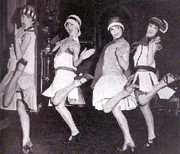==

Shown: Flappers with short hair and skirts, their trademark during the 1920s.
Flappers During the 1920’s, just after World War I, a period of intense fighting throughout Europe, a new culture sprang up throughout the Western World, eventually spreading globally. With the men off at war, women began to venture out of the household, finding more independence than they had ever had before. Part of this growing independence was the movement of women cutting their hair shorter and wearing their skirts shorter. These women soon to be came known as flappers in reference to their loose and short skirts flapping in the wind1. This culture was spread from the United States to across the Atlantic and beyond, following the trends of American Jazz music and other entertainment such as silent films, where girls sported the new look 2.
Las Pelonas: Flappers on the Global Scale
Before World War I, people did not travel internationally on a large scale. However, after the “Great War”, many Americans began to travel, whether that be through vacation or students studying abroad. With this came a great and rapid spread of culture between nations. An example of this is in Mexico with Las Pelonas, or the Mexican version of the flapper. These were women known for cutting their hair short and wearing shorter skirts, seen as the new Modern women1. These modern ideas of cutting ones hair came through the international spread of cinema, and how the popular actresses were cutting their long locks off in favor of a short bobbed cut. However, the idea of cutting off ones hair in Mexico to be modern was not favored by most men in society. Women who cut their hair were seen as wanting to stray away from tradition, by getting rid of their long, thick hair passed down through genes1. As a result, a lot of backlash occurred with Las Pelonas being heckled and tortured in the streets, being seen as too masculine for Mexican society. In 1924, some Las Pelonas were attacked at the University they were attending for medical school. These attacks escalated into a full-blown war between those who wanted to remain rich in tradition and those on the side of Las Pelonas, fighting for modernization. This war would continue for years to come, with conflicts even arising as late as the 1980s. All in all, Las Pelonas represent the modernization and equal rights movement for women, who throughout the 1920s and beyond continued to gain more equality with men.
References
1. Rubenstein, Anne. The War on Las Pelonas. http://www.library.illinois.edu/ereserves/eres-20071219NeJx7/R/Rubenstein_war.pdf
2.Wikipedia. s.v. "Flapper." http://en.wikipedia.org/wiki/Flapper